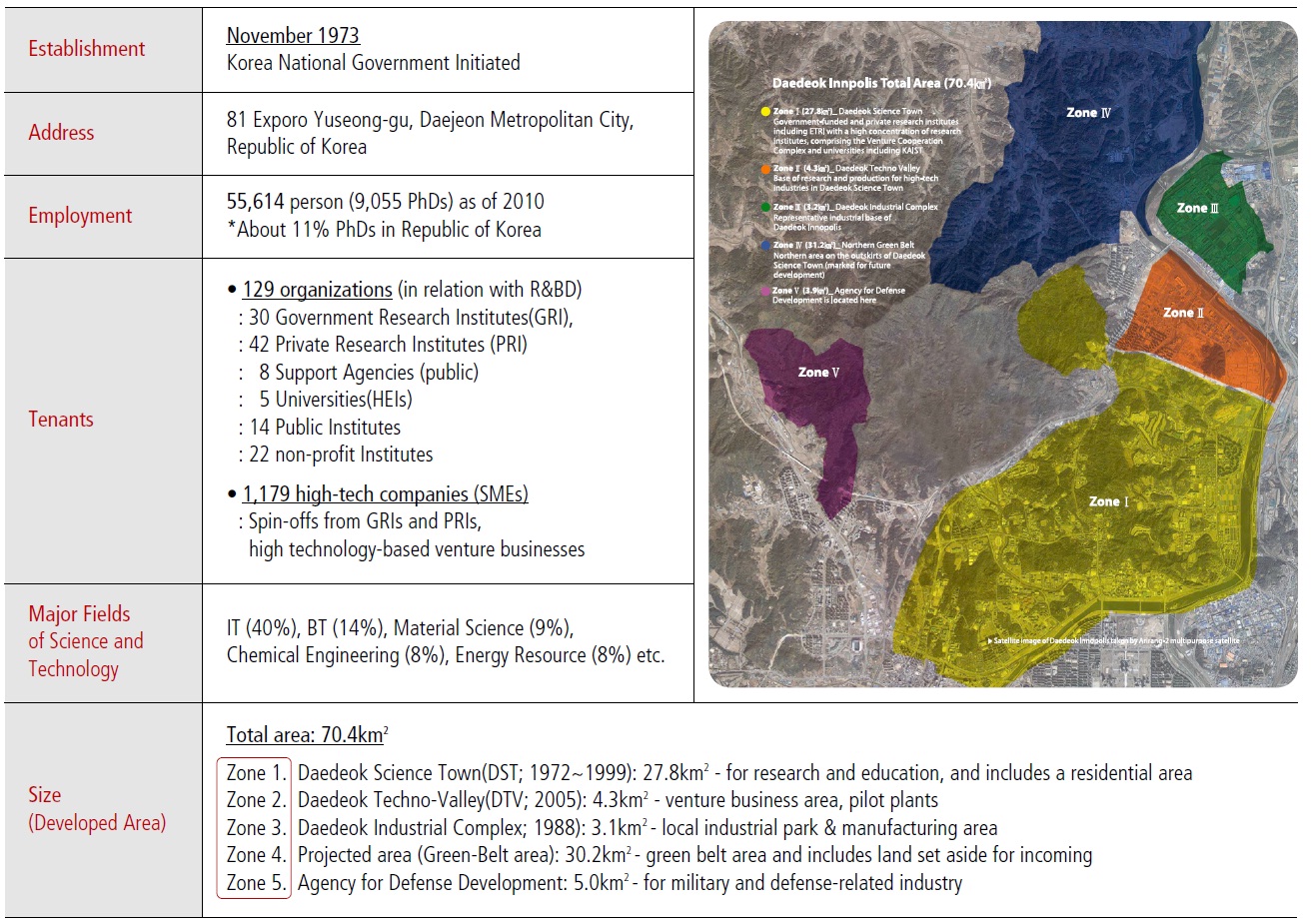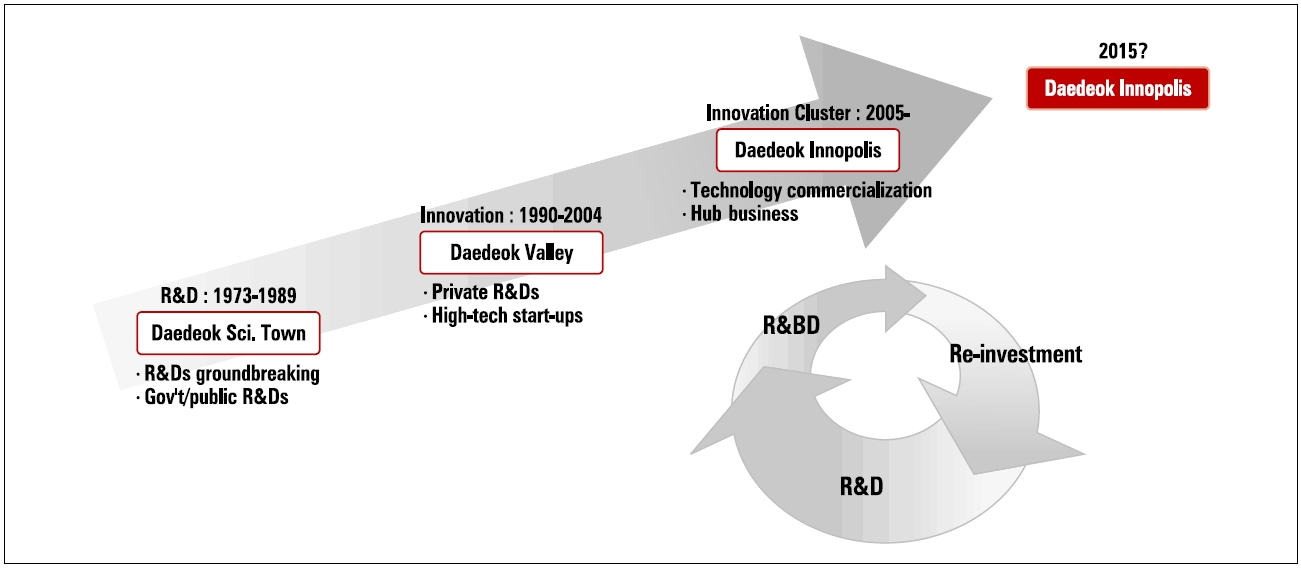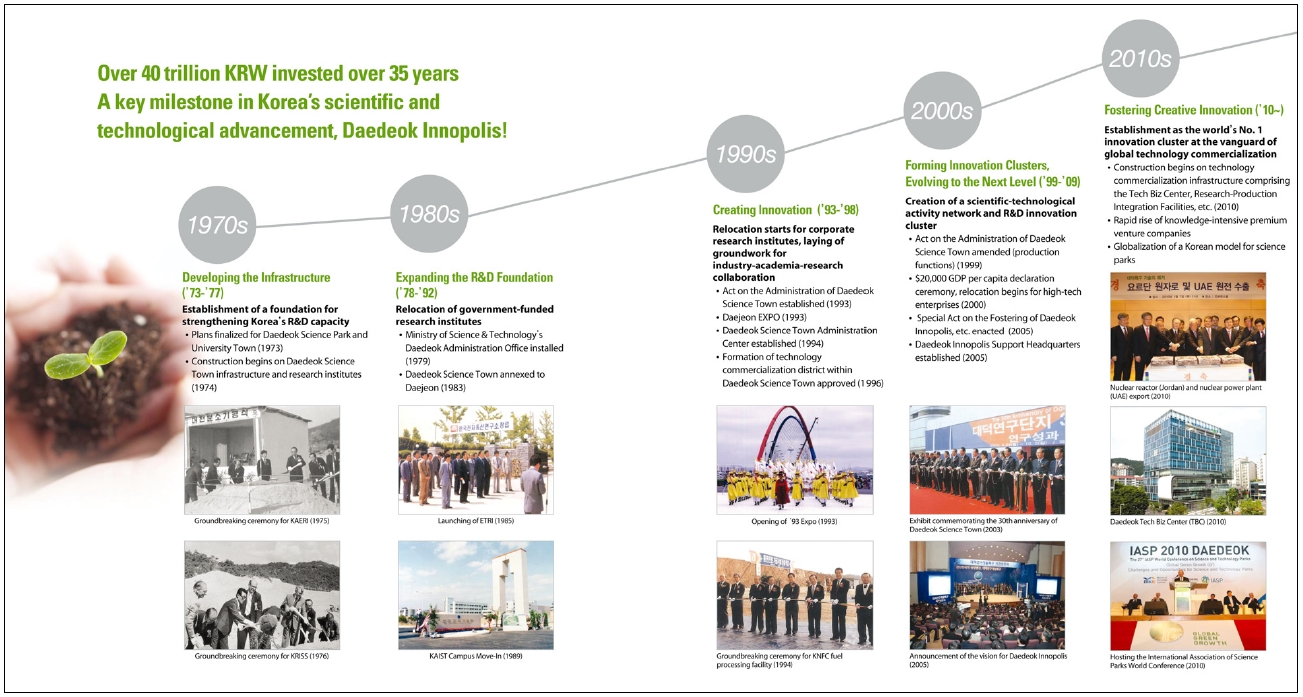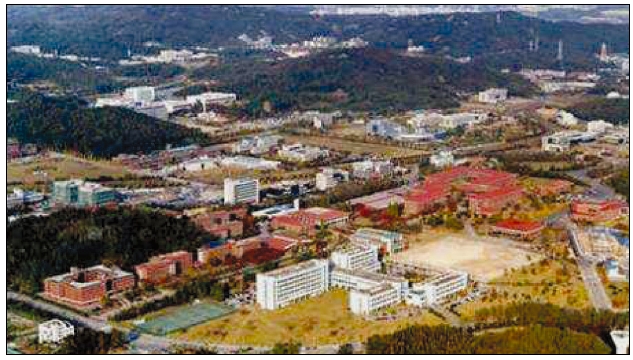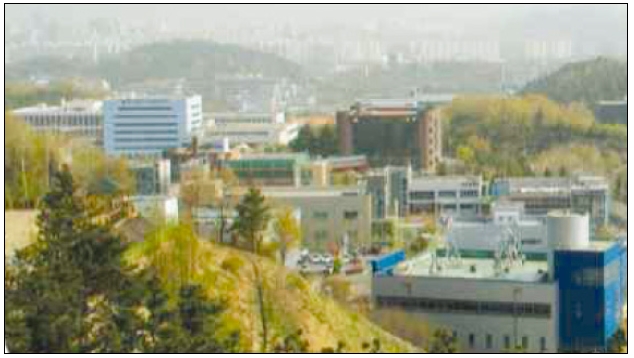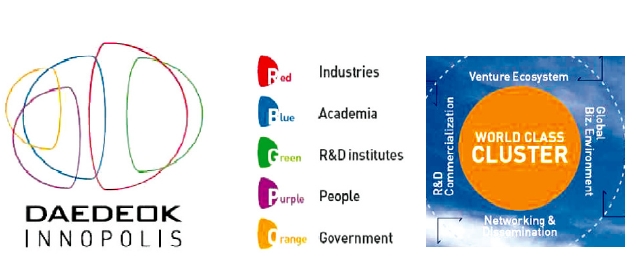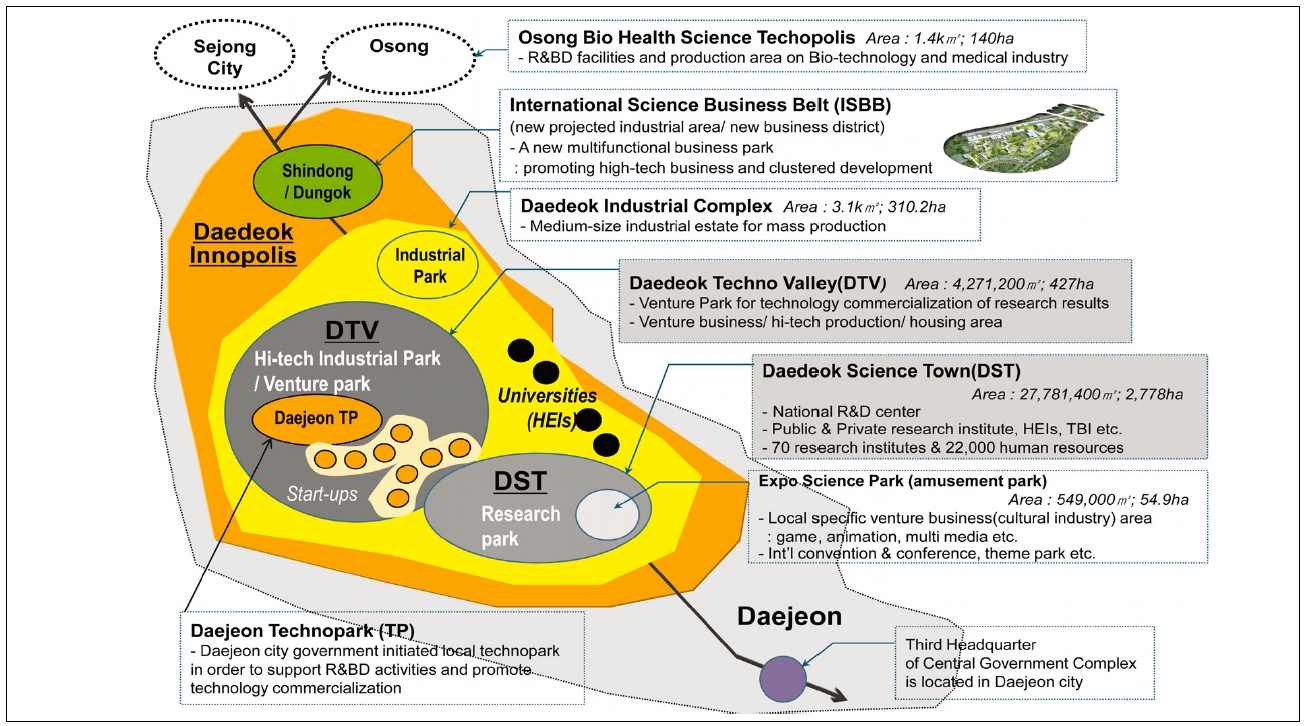



In the Republic of Korea, the science park development began to gain momentum in the 1970s when the Daedeok Science Town (Daedeok Innopolis, since 2005)1 was established as a national R&D center. In particular, the Daedeok Science Town was intentionally created as an engine of enhancing the national competitiveness of high technology and economic prosperity through the agglomeration of research institutes and universities in a planned science city. It brings together many national and regional development policy efforts from the last forty years to achieve technologybased economic growth and regional innovation. In addition, in the early 2000s, Korea’s regional innovation policy has been targeting the innovative cluster as one of critical instruments to achieve sustainable development through networked collaboration between HEI’s, research institutes, industries and government. It is highly regarded that Daedeok Innopolis is playing a crucial role as a regional platform for a comprehensive approach to technology-based regional development in a sustainable context. Daedeok Innopolis (new name) has undergone continuous selfrenewal over the past forty years to better respond to the economic demands of the nation. Today, Daedeok Innopolis has been reorganized as a global-cluster that signifies our entrenchment and renewed commitment to placing Korea’s high-tech prowess in the global spotlight (Daedoek Innopolis Management Office 2010).
This paper will review development of Daedeok Innopolis based on experience over the last forty years (1973~2012). In particular, it will focus on the functional structure of science park development in terms of three different stages of the development model: science park, technopolis, and regional innovation cluster.
2. OVERVIEW OF DAEDEOK INNOPOLIS
In 1973, on a site covering 27.8km2, the Korean government began the construction of Daedeok Science Town. The cost of the development was one trillion Korean won, which was provided by the national government and the private sector. Daedeok Innopolis is located in the center of the nation’s territory, approximately 167 km from Seoul, the capital of Republic of the Korea. At a distance of about one hour from major cities including Seoul, Daegu, and Gwangju, exchanges with regional government officials, industry leaders and researchers are convenient. In total, there are 30 government-funded institutions, 5 universities, over 400 corporate R&D centers, and more than 1,200 hightech companies (SMEs) situated on this site, which is regarded
[Table 1.] Overview of Daedeok Innopolis (2010)

Overview of Daedeok Innopolis (2010)
as one of the most highly favored areas in which to live and work in Korea. For operational purposes, the grounds have been organized into five distinctive zones (See Table 1). Also resident in Daedeok Innopolis are about 11% of all PhD-level researchers in Korea who specialize in engineering and the natural sciences. Established as the shining emblem of Korea’s science and technology, Daedeok Innopolis is now moving beyond science and R&D to take flight as a global innovation center.
Daedeok is a place where people, technology, and nature harmoniously coexist, as well as being a place where business and research activities are conducted efficiently and conveniently. But much more than that, it’s a world-class innovation cluster where creativity openly blossoms and breathes. Daedeok Innopolis is now becoming the sort of high-technology cluster which sports a dynamic and thriving level of production of intellectual property applications based heavily on robust R&D input. With the research institutes and universities together, Daedeok Innopolis comprises very convenient facilities for the commercialization of technology within specialized industrial sectors like IT, BT and NT (Daedeok Innopolis Management Office 2010).
There are three distinct processes in the development of Daedeok Innopolis (see Fig. 2). At the initial stage, DST in 1973 was the sole science town in Republic of Korea which had been developed as a mecca of science and technology with a strong research workforce. DST was intentionally created as an engine of enhancing national competitiveness in high technology and economic prosperity through the agglomeration of research institutes bringing together many national and regional development policy efforts over the last 40 years. The DST research complex was built with the investment of $3.16 billion over the past 3 decades to better respond to the economic demands of the nation. It also possesses a vibrant mixture of next generation technologies such as IT (Information Technology), BT (Bio- Technology) and NT (Nano Technology). As mentioned before, it has been well developed with a healthy balance between research institutes, academic institutes, industries
and the public sectors, where they possess the model of the next “Silicon Valley” here in Republic of Korea. Recently, venture parks are being actively developed in order to cover the huge number of high-tech SME’s produced through below DST’s development.
The first development phase began in the 1970s when the National Science Town was established at Daedeok, in Daejeon. The master plan represented a concrete attempt by central government to create a science city outside the capital region. In particular, it was expected that DST could enhance research efficiency through a systematic and comprehensive R&D investment for each institute, creating an optimal research environment for the mutual exchange and application of a variety of information, knowledge and know-how, and promoting investment effectiveness by the shared use of facilities, manpower and projects. In order to achieve these aims, the development of DST in the initial stages was centered on public sector research institutes and nationally funded universities (Oh and Masser 1995). The dominant role of the government is particularly evident in the initial stages of DST development, as DST was established by a central government initiative; local authorities were excluded from the initial planning of the science city program particularly that of DST. Because of exclusion, there seems to be a weaker link between the technopolis and regional industrial development, than there otherwise might have been. In the 1980s, the function of DST was to establish a R&D center for government supported institutes and industries through the relocation policy of central government. In the early 1990s, completing construction of DST became a high priority. There was a change in the expectations of the role of DST due to the changing economic and social climate. In the original plan, DST was envisaged to play a role as a center for pure scientific research in Republic of Korea. However, recently applied research and development that is directly applicable to commercialization has become an expectation. Therefore, DST has been criticized for being unable to adequately fulfil such needs.
DST was initially planned as a satellite city. Even though DST is close to its mother city Daejeon Metropolitan City, the relationship between DST and regional economy in Daejeon was not positive. The location of DST was only important in terms of national goals. When DST was incorporated administratively into Daejeon in 1983, DST was merely a secondary urban center. DST is faced a new turning point in terms of its role for urban structure. The DTV (Daedeok Techno Valley) is a bridge between pure science city and technopolis towards regional innovation strategy to generate a maximum synergy effect by linking these critical areas functionally and spatially. DV can be understood as the comprehensive approaching policy to contain DST’s R&D function, technology commercialization of DTV and mass production by local industry.
Since the mid 1990s, efforts have been made to enable high-tech venture firms to be established in DST with mechanisms to support the commercialization of R&D results achieved. Its main components were TBI (Technology Business Incubator), Post-TBI, and a venture park, where start-up firms can make their efforts in commercializing their new technology. In this consideration, Daejeon Metropolitan City Administration mapped out a scheme to develop a high-tech industrial district, Daedeok Techno-Valley (hereafter DTV).
In 2002, the central government designated DST and its vicinity as DV for the further development of technology commercialization based on R&D. This variety of high-technology based developmental activities enabled the DV to be re-designated the first National Special R&D Zone,2 entirely encompassed within the Daejeon Metropolitan City: Daedeok Science Town (DST), Daedeok Techno-Valley (DTV), Industrial Complex, and Yuseong Tourist Area. This zone was commissioned to carry out the pilot project of regional innovation and technologyled economic development with strong support from the central government. DV development provided important opportunities for regional development. First of all, DV linked with DST and DTV, the largest science and technology research park in Korea, providing an important hub for leading the regional industry through the efficient development of advanced science and technology (Daedeok Techno Valley Corp. 2001).
>
Mature stage (2005- ): Innovation Cluster
According to a 2006 report by Daedeok Valley Management Office (DVMO), within 10 years, Daedeok will have obtained immense growth, with the number of our occupant companies and R&D institutes and the number of international patent registrations rising dramatically. In particular, the companies in DV are estimated to be at 3,000 units in 2015, and the number of foreign R&D institutes is expected to register 20 in 2015, up from 2 in 2004. In addition, DVMO is predicting the international patent registration will grow to about 10 times the number from 2004, and the sales by technology commercialization are expected to reach $31,296 million in 2015.
Over the years, Daedeok Innopolis has served a critical role in raising Korea’s scientific competitiveness to global top-4 status (IMD Switz. 2010). On the solid foundation furnished by the cutting-edge convergence and integration of R&D capacity of government-funded institutes, the cultivation of top minds in science and technology at top-tier universities, and the growth of technology-intensive venture companies through the commercialization of R&D results, Daedeok Innopolis is fast advancing toward its goal of becoming a world-class innovation cluster and hub for global technology commercialization. Daedeok Innopolis has consistently produced R&D results that have formed the foundation for Korea’s economic growth. Such proud achievements include CDMA, which has become the global standard for mobile communication; WiBro; terrestrial DMB; the export of Korean nuclear reactors to the UAE; the Korean-made global new drug Factive; the Arirang satellites; and the nuclear fusion research device KSTAR. In addition, Daedeok Innopolis has been creating a business-friendly environment complete with a global network and support for industryacademia- research collaboration, as well as strengthening the management capabilities of future entrepreneurs. Through such efforts, it is being reborn as a stronghold for state-of-the-art technology enterprises that compete on the world stage.3
Only recently, Daejeon city as a Technopolis, leading the Korea's science and technology development, applied for the National Project (Official title: Korea’s National Project on International Science Business Belt; hereinafter referred to as “ISBB”), which is funded by Korean Ministry of Education, Science and Technology for the years 2012~2017(six years, total budget:$4.5 Billion). The ISBB will be a national platform to promote high-tech business and clustered development in the areas of innovation, science and technology. On May 16, 2011, Daejeon city was adopted as the host city for the location of the ISBB. This project aims to establish the National Platform of Korean Science & Technology in order to promote capacity building of R&BD as well as foster the global competitiveness. Within this framework, Daejeon City has extended its international network with global science cities, as well as, promoted foreign investment.
1 Keeping step with the growing size of the park, the name has twice been changed from Daedeok Science Town (DST, 1972-1999) to Daedeok Valley (DV, 1999-2004) and Daedeok Innopolis (2005-present).
2 Daedeok Innopols is a hub for global technology commercialization, combining R&D, business, and production. It was designated as an R&BD special zone in pursuance of the special act on the fostering of Daedeok Innopolis in July 2005.
3 Source: Daedeok Innopolis Management Office (2011); Daedeok Innopolis also operates a wide variety of programs for successfully commercializing new technologies, and uses its rich store of accumulated know-how to synergize the nation’s topmost R&D capacity with organic cooperation and exchange between industry, academia, and research. By completing a hub-and-spoke system linking its unique research capacity with advanced industries across the country, Daedeok Innopolis is firmly establishing itself as Korea’s R&D hub and regional innovation cluster in cooperation with its mother city, Daejeon Metropolitan City.
3. STRUCTURE AND WORKING MECHANISM WITH DIFFERENT STAGES OF DEVELOPMENT
3.1 Science Park model at the Initial Stage
The development feature of Daedeok Science Town at the initial stage shows us the model of a science park. As a national hub for development of science and technology, the main objectives in the initial stage of the Science Park are:
Constructing infrastructure: Designing, developing, and managing the Science Park. Also includes forming connections with other cities and regulating development of the Science Park (Regulating green areas, building-toland ratio, floor space index, and etc.).
Managing and operating the Science Park: Harmonizing R&D facilities, amenities, and welfare facilities with each other. Also includes maintaining the balance between supply and demand in the Science Park.
Constructing institutional infrastructure: An institutional structure to regulate environmental pollution, to activate business and R&D activities, and to enhance the convenience of residents should be established.
This science park model contains three main functions: R&D, Business and Infrastructure. Management is only limited to infrastructure-related service. In terms of research & development, research and education were led by research centered HEIs. Training of experts in basic science was improved. Public research institutes focused on conducting national R&D projects and constructing national R&D infrastructure. They also focused on the construction of a national framework of science and the development of strategic industries with a long range vision. Private R&D institutes formed a hierarchical relationship with their mother firms and concentrated on R&D related to their mother firms. They focused on building R&D infrastructure and R&D activities. In this stage, the commercial potential of R&D results in basic science or engineering from research centered HEIs promoted the construction of the Science Park: Business incubation centers and technology exchange centers were built in HEIs and R&D institutes to support technology commercialization. Collaborative R&D also began. R&D experts trained in research concentrated HEIs led technology commercialization activities.
[Table 2.] Functional features of Science Park Model
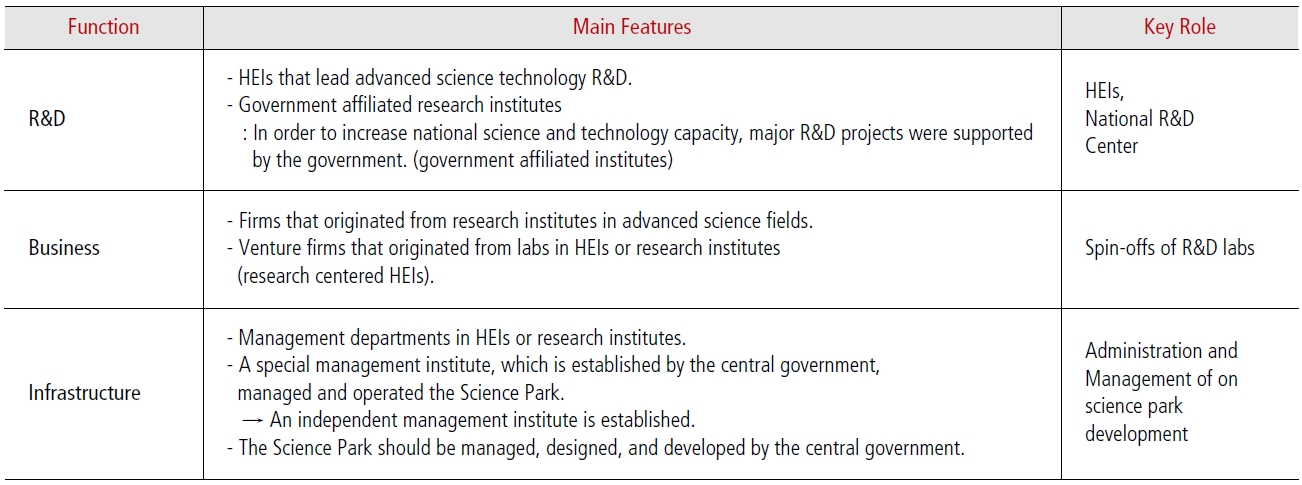
Functional features of Science Park Model
In terms of Business & networked Entrepreneurship, the Daedeok Science Town focused on non-industrial basic science activities in the initial stage. Thus entrepreneurship activities were barely present at this stage. Business incubation activities were barely supported in this stage. The only business incubation space provided were labs in HEIs. Business incubation was limited to business start-ups in labs of HEIs. In order to support business start-ups, a systemized business incubation system is required for example, Pre- Incubation systems, TBI projects in HEIs. The venture capital methods in this stage were mainly Angel Funds, which is a type of Risk Financing. Funds were mainly provided to venture firms by individual investors (Risk Financing). Thus, venture capital services were barely existent. Only lab business start-ups in research concentrated HEIs were supported in this stage. Administrative networks among public research institutes were formed. R&D activities were mostly conducted with government aid. Thus, independent networksbetween institutes were barely existent. More networks should be formed among firms, HEIs, and research institutesto promote R&D activities and to support business incubation.In this stage, technology commercialization and venture activities were mainly conducted in labs located inside research institutes and HEIs.
Main infrastructure in the initial stage, Science Park was limited to R&D related facilities such like R&D center, HEI etc, which did not contain industrial functions. Initially this park was designed as a research and education city. A legal structure to regulate land-use should be established. The Science Park was initially built as a national science and technology city, so business activities were not recognized in the initial stage. Legal structures or institutes that manage business facilities did not exist in this stage. The function of Science Park Management Office includes designing the Science Park, selecting occupying institutes of the Science Park, and other management functions. Education, research, and residential facilities were harmonized with each other in the Daedeok Science Town.
In summery, main functions are R&D, Business activities and Infrastructure. The management is limited to maintenance service. The components of key role are HEIs, National R&D Center in R&D function, Spin-offs of R&D labs in Business function and management office in Infrastructure function.
3.2 Technopolis model at the Middle Stage
At the middle stage of Daedeok Innopolis development shows us the technopolis model. The Technopolis model is a total system for innovation and technology commercialization. This model is operated in the composition of four main functions and their components.
In this stage, HEIs and research institutes actively supported business incubation activities: containing legal support, constructing infrastructure (business incubation center, and etc.). Cooperation between the Science Park and the local government, which governs the city where the Science Park is located, is important for collaborative activities. In order to expand R&D activities into technology commercialization
[Table 3.] Functional features of Technopolis Model
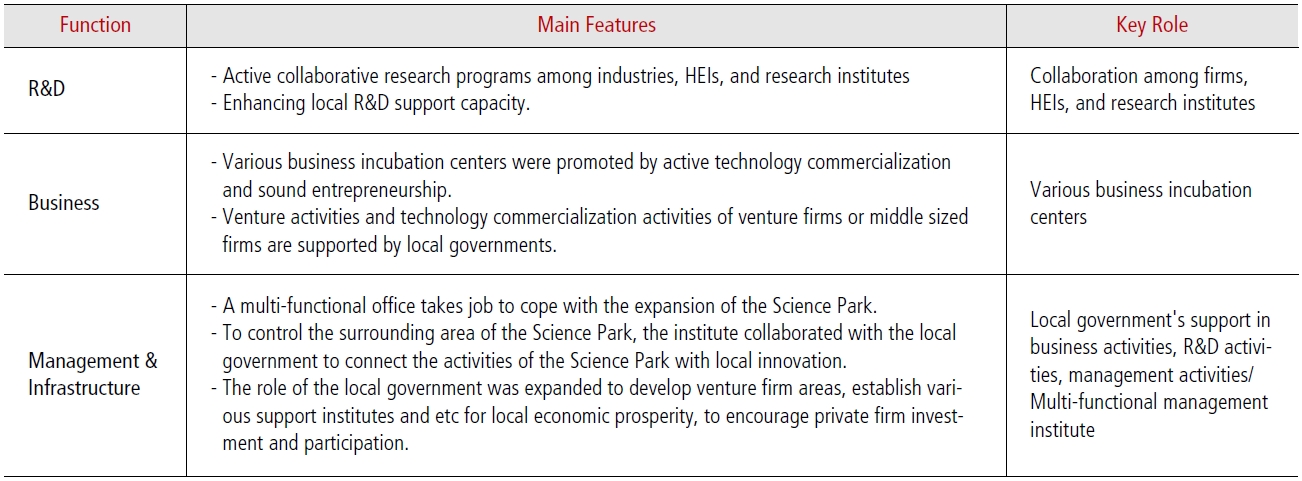
Functional features of Technopolis Model
activities, R&D capacity of the Science Park was enhanced. In addition industrial areas were expanded next to Science Park. At the same time, as various infrastructures were expanded in the Science Park, a legal structure to efficiently manage and operate the infrastructures was established. Venture firms were created and the roles of HEIs became more important in this stage. All HEIs, including research centered HEIs and local engineering HEIs, conducted technology commercialization and collaborative research with firms, research institutes, and HEIs.
Main features of Technopolis development at middle stage are as follows. In terms of Research & Development, HEIs became more important, since they are the source of venture firm start-ups. Various local HEIs moved into the Science Park and contributed in collaborative R&D activities with other firms and research institutes. HEIs mainly conducted research projects offered by the government with the help from public research institutes. With research centered HEIs and local HEIs participating actively, R&D activities in the Science Park were enhanced; the groundwork for venture firm start-ups was established. Research projects given by the government were conducted by HEIs. Public research institutes led collaborative research projects with industries and HEIs, conducted research contracts offered by private firms, and etc. Commercialization of research results began in public research institutes; promoted start-ups of venture firms. As HEIs’ and firms ‘R&D activities increased and expanded, public research institutes’ functions increased and expanded. Public research institutes supported the creation of venture firms by establishing business incubation centers, and etc. In government affiliated research institutes, national R&D projects and collaborative R&D projects were conducted. In the process, technology commercialization, technology transfer, spin-off activities occurred. In order to support these activities, support systems such as business incubation systems were established.
In terms of Business & Networked Entrepreneurship, a system to utilize research results from research institutes and HEIs in order to support potential entrepreneurs and venture firms is necessary. Business incubation activities should be expanded from a small number of public institutes and HEIs to various local institutes. Also, business incubation activities should be integrated and diversified to promote regional development. There should be an integrated support system for venture firms, which includes customized business incubation, specialized collaborative networks, venture communities, venture capital programs in order to support venture firms efficiently and flexibly.
In terms of Management & Globalization, the management and operation of the technopolis should become more professionalized. The management and operation services should include education programs which are developed by public institutes, financial aid for venture firms, marketing services, institutional support, various equipments, facilities, and etc. Technology Commercialization was the core topic of education programs: Technology marketing, technology management, technology commercialization, advertisement of products, and etc. Financial aid was provided to venture firms in order to help venture firms to settle down and make progress. A financial aid system that focuses on supporting venture firms was established by the central government. Local governments also adhered to the central government’s policy of supporting venture firms and their growths; the functions of business incubation centers established by local governments were enhanced to also provide financial aid. An integrated operation and management office was established instead of individual operation and management institutes. It was an integrated system that synthesized the governance of the Science Park like management, infrastructure maintenance etc. The cooperation with local governments was taken for the sustainable development of technopolis.
As a function of Infrastructure, industrial space for venture firms and R&D facilities was expanded in order to expand early R&D activities to technology commercialization. As various infrastructures in the Science Park are expanded, a legal structure was necessary to efficiently manage and operate the facilities. A structure and the division of roles in R&D facilities, business facilities, management-facilities were established. Accessibility quality of life enhanced in terms of transportation, land-use, and amenities. The integration of culture and society with local residents was emphasized to make best use of mother city’s infrastructure.
3.3 Innovation Cluster Model at the Mature Stage
At the mature stage of development, Daedeok Innopolis takes innovation cluster model: a center of business excellence on high-tech industry in the global science. In order to establish an innovative cluster, the collaborative system among firms, HEIs, and research institutes are enhanced. Regional innovation cluster of national or local strategic industries are created in Daedeok Innopolis. A specialized science and technology network is established to maximize innovation of science and technology. At the end, global marketing strategies were enhanced. We are trying to attract foreign institutes and foreign investment into the Science Park. In particular, a cooperation system among firms, HEIs, and research institutes was enhanced in strategic industrial fields such as IT, BT, and NT. As a result, an innovative cluster was built and collaborative R&D is actively conducted in order to foster technology commercialization. Numerous networks among firms are created in order to support technology commercialization and business activities.
In this experts in science & technology and integrated professional training programs are required to build an innovative cluster. It is important to create clusters of related institutes to promote the growth of strategic industries. Financial aid and support in specific technologies are also important. Cooperation with international innovative clusters and global marketing strategies induces synergy effects in the development of science and technology.
In innovation cluster, pleasant residential areas and strategic high-tech industries should be harmonized with each other. In addition, the cluster was developed into an innovative cluster, which leads local innovation. Land-use should be improved to activate high-tech R&BD activities. A systematic and integrated structure of R&D facilities, business facilities, and management facilities are required in order to promote the development of high-tech strategic industries. A multi-purpose site was established in Daedeok Innopolis to attract strategic industries, foreign advanced research institutes, and foreign research centered firms into Daedeok Innopolis. An international support infrastructure was established to enhance global competitiveness.
The main features of science park development at mature stage are as follows.
As a function of Research & Development, research centered HEIs led R&D activities in national strategic industries. Core science fields such as IT, BT, and NT fields were mainly researched in order to increase national competitiveness. Through collaborative researches among HEIs, research institutes, and industries, technology commercialization was conducted. HEIs’ roles and functions were diversified. In order to maximize the efficiency of technology commercialization activities, R&D activities in specific fields were supported by public research institutes. By creating clusters of strategic industries, technology can be accumulated. Continuous R&D activities and the formation of strategic industry clusters are required for technology innovation.
In terms of Business & Networked Entrepreneurship, an institutional system and infrastructure was established to support entrepreneurship activities. This led to the construction of an innovative cluster. Potential entrepreneurs in strategic industries were discovered and supported to build an industrial cluster and a Regional Innovative System(RIS). Business incubation services, including the provision of space and facilities, institutional structures, and etc. were improved. As a result, venture firms became more active. Professional support services such as business consulting, technology marketing, and etc. were provided as part of business incubation programs. Business incubation pro-
[Table 4.] Functional features of Innovation Cluster Model
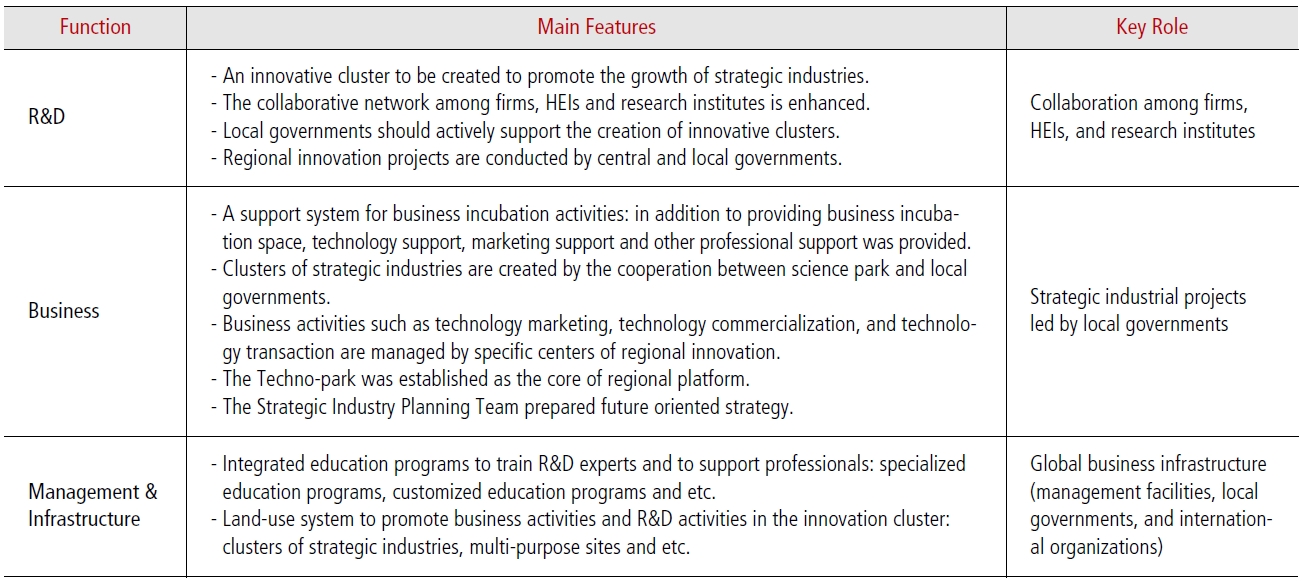
Functional features of Innovation Cluster Model
grams were customized and divided into three stages. These systemized business incubation programs efficiently supported the settling down of venture firms. Business incubation programs supported venture firms to settle down and ultimately, the venture firms contributed to the establishment of an innovative cluster.
In terms of Management & Globalization, a RIS should be established by the government. An education department should be established in the RIS in order to provide a customized education program for different regions. The customized education programs should focus on technology commercialization and business incubation. Education programs in specific fields or retraining programs should also be diversified. Consistent education programs should be offered by education institutes such as the University of Science and Technology, The Technology Management Graduate School, Patent and Law Graduate School, and etc. In order to establish an innovative cluster, financial aid is necessary in high tech fields. Technology marketing has to be supported in different technology clusters. Financial aid should be provided to specialized or advanced technologies. Cooperation among different technology clusters is necessary. Cooperation networks were created among related institutes in the Science Park. These networks were built by the management Office of the Science Park and local governments. Clusters were built inside the Science Park and cooperation between domestic clusters and foreign clusters was encouraged.
4. IMPACT ON ECONOMIC GROWTH AND REGIONAL INNOVATION
The volume of employment created in Daedeok Innopolis is relatively small by global standards. However, taking into account that Daedeok Innopolis’ employment consists of professional manpower which is the center of knowledge and technology, Daedeok Innopolis’ employment is more meaningful in terms of future oriented development. Highly trained research manpower in public and private R&D center has been concentrated in Daedeok Innopolis for the last 40 years. 129 institutes are currently located in Daedeok Innopolis. Private research institutes are major occupants and government funded research institutes are following. However government funded institutes were the number one occupant of the Park until 1990, but private research institutes took over that position from that time forward. Investment organizations began to show up from the mid 1990s, about 20 years after initiation of Daedeok Innopolis (Daedeok Science Park was established in 1973), but it grew very slowly from 2000 (Oh and Kang 2009). Daedeok is a good place to transfer technology and science to nearby firms but it does not hold a sizable population. Therefore, it seems that threshold of investment organizations in Daedeok Innopolis does not exceed a certain number. There are about 24,000 researchers including 9,055 PhD holders who work in private, public research institutes and universities.
[Table 5.] Institutions and employments in Daedeok Innopolis (1979-2010)

Institutions and employments in Daedeok Innopolis (1979-2010)
It can be argued that there is a high possibility of commercialization of research results or high-tech commodity from high-tech researches in Daedeok Innopolis. No other place in Korea has as many focused researchers as Daedeok Innopolis. Foreign scientists began to settle in Daedeok Innopolis from 1999 and about 300 people are conducting research now.
Regional impacts on economic growth of Daedeok Innopolis are appearing through rapidly growing venture business. From the late 1990s, active spin-offs from research institutes and universities have been happening in Daedeok Innopolis. Although several previous assessments indicated that the mere concentration of public and private research organizations in one location couldn’t generate the incidence of high technology spin-offs. Similar types of organization in Daedeok Innopolis have been significant source of technology-oriented new ventures, and Daedeok Innopolis ‘fervor for venture startups had spread into whole of Daejeon area from the late 1990s.
Growth of venture business is shown in sales increase. According to the investigation of Daejeon Metropolitan City, the amount of turnover by venture business was $7,773 thousand in 2004. Over the last 15 years, venture firms in Daedeok Innopolis have made outstanding progress. The rate of growth of venture firms exponentially increased. Economic impact from the venture firms to the regional economy is not significant but growth rate is very high. The volume of sales from venture firms located in Daedeok Innopolis in 2004 was nearly four times that of 1999. Venture firms start-up was initiated from the end of 1980s and itgrew up very slowly until IMF Crisis in Korea. But it grewvery rapidly from year 1999 on due to the central government’ support policy for venture firms to achieve economic prosperity to cover up loss from the IMF Crisis. Job creation from the venture firms was recognized by the citizen of Daejeon Metropolitan City from year 2000.
Business incubation plays the role of connecting science and technology to real markets and economic development. Key functions for a successful business incubation is proper planning, management, location selection, making connections with universities, positive marketing, establishing global networks, providing financial aids, etc. With the establishment of an incubation center in KAIST (1994), about 20 business incubating organizations exist in Daedeok Innopolis now. They belong to universities, research institutes, government institutes and private firms. Currently about 322 venture firms are under incubation and some 3,000 employees are working with funding from the government or out of Daedeok Innopolis.
Intellectual property accumulated in Daedeok Innopolis is very rapidly growing. According to a 2010 report by Daedeok Innopolis Management Office, the number of domestic patents have increased from 12,289 in 2000 to 40,348 in 2009. It was nearly four times during the last nine-year period. In case of international patents, the number of patents have also increased from 2,026 in
[Table 6.] Trends in business incubation centers in Daedeok Innopolis(1998-2007)
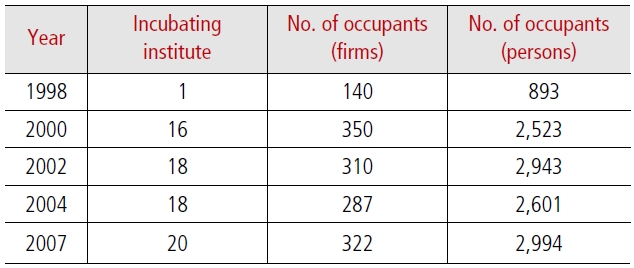
Trends in business incubation centers in Daedeok Innopolis(1998-2007)
2000 to 7,684 in 2009. These statistics mean that Daedeok Innopolis is the hub of knowledge innovation and the center for future oriented growth in the knowledge-driven era in Korea.
Network building by Industry-Academia-Research collaboration system have been formed among universities, public research institutes, private research institutes, and firms. These networks are created for the innovation and development of science and technology. The networks are often specialized in specific industrial fields in the science park. In particular, Daedeok Innopolis as a center of the RIS (Regional Innovation System) has been played an important role of growth engine to interact in many fields like R&D, production, administration, institution activities, cultural activities, etc. The RIS promotes innovation and develops the region’s science and technology. The RIS is built by connecting dispersed regional innovation resources and is utilized as a central institution to enhance the regional economy and industrial development. In Daedeok Innopolis, a strategic industrial innovation cluster was built in the region and plays an important role in regional development. In addition, Daedeok Innopolis is a mecca of technology commercialization in Korea that operates a wide variety of programs for successfully commercializing new technologies, and uses its rich store of accumulated know-how to synergize the nation’s topmost R&D capacity with organic cooperation and exchange between industry, academia, and research. By completing a hub-and-spoke system linking its unique research capacity with advanced industries across the country, Daedeok Innopolis is firmly establishing itself as Korea’s R&BD hub and super-regional innovation cluster.4
4 R&BD infrastructure built in Daedeok Innopolis promote technology commercialization by combining R&D results with successful business, there is an unique ecosystem of institutions, facilities, and infrastructures provides fertile ground for commercializing new technologies. Daedeok Innopolis boasts a high concentration of government and private agencies that support R&D and technology commercialization, including the Daedeok Innopolis Support Headquarters, the National Research Foundation of Korea, the Small and Medium Business Support Center, and Daejeon Technopark. It also offers an excellent array of infrastructures for technology commercialization support, including Daedeok Tech Biz Center (TBC) and Research-Production Integration Facilities.
In this paper, we reviewed the model of science park development based on the experience which is accumulated in Daedeok Innopolis for the last forty years (1970-2010). Through the case of Daedeok Innopolis, the types of science park development and their functional structures were reviewed. We also exploited the main issues of science park development by main functions and detailed components.
- Three steps of science park development are identified such as science park, technopolis and innovation cluster in accordance with science park development stages.
- Four main functions (R&D, Business, Management and Infrastructure) and their detailed components are suggested through the analysis of 11 international experiences including Daedeok Innopolis.
■Three clear phases of science park development were identified in Daedeok Innopolis as follows;
- Science parks at initial stage: a national hub for development of science and technology
- Technopolis at middle stage: a synthesized system for innovation and technology commercialization
- Innovation cluster at mature stage: a center for business excellence of high-tech industry in global science.
Finally, as a hub science park for not only Northeast Asia but the entire world, Daedeok Innopolis is growing and evolving into a global innovation cluster by building on the firm foundation provided by industry-academia-research-private- public cooperation among resident institutes, enterprises, and universities. In order to turn R&D results into commercial success, Daedeok Innopolis has built R&BD infrastructure as well as has established a virtuous cycle of R&D since 1970. By combining R&D results with successful business, Daedeok Innopolis also has contributed to regional economic development, as well as, establishment of innovation cluster with global competitiveness of science and technology in the world market. Daedeok Innopolis management office (2010) summarized the evaluation of their activities in following sector.
Industry: In Daedeok Innopolis, with its high concentration of R&D functions, technology-intensive venture firms achieve rapid growth and new technologies find active world application through start-ups. In the years ahead, Daedeok Innopolis will serve as both cradle and stronghold for thousands of high-tech venture companies, a place where stateof- the-art technologies and the finest entrepreneurship in the world come together.
Academia: Some 10% of all PhD level engineering and science researchers in Korea are concentrated in Daedeok Innopolis, giving it the greatest capacity for R&D in the nation. By nurturing world-class scientists and research professionals, Daedeok will play a crucial role in the cultivation of world leaders.
Research: In Daedeok Innopolis, state-funded research institutes and corporate research centers with proven records of technological innovation in such fields as IT and aerospace engineering are working ceaselessly to produce the world’s best achievements in R&D. By carrying out advanced technology-based convergence research utilizing some of the finest research infrastructures available anywhere, they will serve as a bridgehead in Daedeok’s journey to becoming a global innovation cluster.
In particular, high-qualified innovation manpower are also the driving force behind the technological creativity and cultural diversity characterizing Daedeok Innopolis. Building on its vision of Human & Science, Daedeok Innopolis will continue to grow and develop through the harmony of passion and enterprising spirit.
Thanks to the generous investment and support of central and local governments, who continue to serve as Daedeok’s facilitator, patron, and partner, Daedeok Innopolis is rapidly transforming into a shining hub of global innovation of hightech sectors including technology commercialization.
